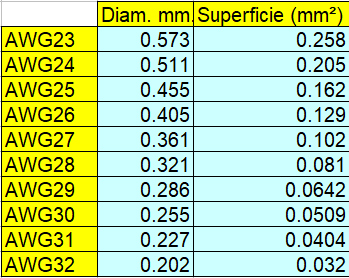In the specifications of network cables, and cables in general, there is a number expressed in AWG. The AWG number measures the cross-section of the individual conductors within the cable. Obviously, the larger the diameter of the conductor, the more current can flow through it (and more data). AWG does not measure the diameter of the cable but measures the cross-sectional area of the conductor. The AWG numbers decrease as the section increases. This is counter intuitive and often leads to errors, but a 27 AWG wire is smaller than a 23 AWG wire. Why does it go backwards? Because to get a very thin wire you had to make multiple passes through a tool to thin it, so a higher number of AWGs = more passes.
Here is a diagram with the most interesting parameters of the most common AWG numbers in network and PC cables: 
So for example the difference between an AWG23 cable and an AWG26 one, as is often found in network cables, is enormous.
We are talking about a 30% smaller diameter and half the surface area; When comparing two cables this is an important parameter of the evaluation.
Even in USB cables, AWG32 or AWG28 conductors are often found inside the single cable. Here too the difference is significant, we are talking about a 60% larger diameter and a surface area that is almost triple.
It becomes a very important factor because it affects the charging speed, especially of the latest smartphones, and the data transmission speed.
subrack.eu + armadi-rack.it© are run by M.D.W. srl - About Us
M.D.W. srl Chamber of Commerce, Bologna
REA n° 465866
PI/CF 02766841205
Legal office:Piazza Minghetti, 4/D
Bologna 40124 BO, Italy
Operating office:Via Edmondo De Amicis 7
Casalecchio di Reno 40033 BO, Italy